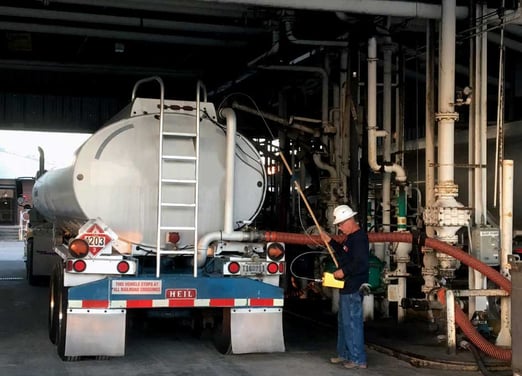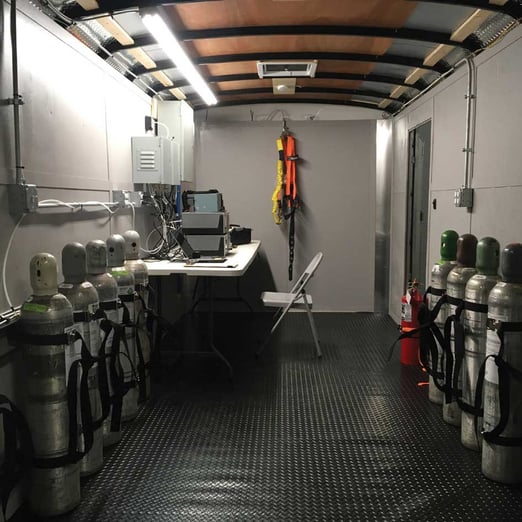The Methane Misdirection
CATEGORIES:
Jim Stamm, Zeeco Inc., USA, explores accurate measurement of hydrocarbon emissions in the presence of methane.
The Clean Air Act in the US created a number of industry-specific regulations under Title 40, Part 60 of the Code of Federal Regulations (40CFR60). These regulations are referred to as New Source Performance Standards (NSPS) and affect a number of industries ranging from refineries to landfills. Subpart XX specifically addresses the performance and emissions from bulk gasoline terminals. The regulations in Subpart XX dictate how vapour processing systems must demonstrate initial compliance with the subpart’s emission standards.
Monitoring Emissions
There are other parts of the NSPS regulations that describe how terminals must monitor performance and show compliance once the initial tests are finished. At the crux of any NSPS compliance system is the continuous monitoring system, often referred to as a continuous emission monitoring system (CEMS). It is the job of the CEMS to accurately measure emissions from an emission source and to then create a permanent record. If the facility is in compliance, the CEMS will show that emissions were at or below the emission standard for a particular site.
Owners and operators of a CEMS at the terminal level must be familiar with the requirements of the CEMS, as delineated in the NSPS regulations, in order to properly manage the compliance of their facility. The applicable requirements can be found in these sections of the NSPS:
- Performance Specification 8 (Appendix B)
- Quality Assurance Procedures (Appendix F)
- Analytical Test Methods (Appendix A)
- General Provisions (40CFR60.13)
- NDIR offers several benefits including the following:
- Operates well in industrial environments
- Low power consumption
- Not adversely affected by weather
- Does not require supplemental gases such as hydrogen
NDIR technology operates under the principle that gases containing a specific chemical, or group of chemicals, will adsorb a proportion of light based on the concentration of that chemical present. Using this premise, the NDIR analyser may be set and calibrated to accurately measure the concentration of a chemical on a real-time basis. Though NDIR may be used in a number of applications, it is particularly well-suited to measure the alkanes (straight chain hydrocarbons) that are normally found in gasoline vapours.
NDIR analysers have been used in a CEMS at bulk fuel terminals for a number of years and have been proven to be a reliable means of monitoring emissions. The NDIR analyser will effectively follow EPA test method 25B through measuring emissions by shining infrared light of a specific wavelength through a sample of vapour or gas and then measuring the amount of light absorbed. The higher the concentration of the target compound, the more light will be absorbed. Under this method, the analyser may be calibrated to either propane or butane as a standard. Though either gas is allowed under the method, most facilities use propane. Upon selecting a calibration gas type, all emissions are measured and expressed as an equivalent of the calibration gas (e.g. when calibrated to propane, emissions are expressed as an equivalent of propane). Using a CEMS equipped with a NDIR analyser, terminals have been able to monitor and document compliance for a number of years.
The NSPS regulations not only specify the appropriate monitoring devices but also define the necessary programmes to ensure that the CEMS and their monitors are operating correctly. Two significant quality measurements are:
- Daily span or drift checks
- Relative accuracy testing
Daily span checks involve introducing gases of known value to the NDIR analyser and ensuring that it meets certain requirements for accurately identifying the gas. Drift check requirements are presented and discussed in Appendix F of the NSPS regulations.
Relative accuracy testing is more involved and consists of measuring emissions from the vapour processing system using both a CEMS and a second reference analyser proven to meet its own quality measures. The relative accuracy test is also referred to as an audit and is often called a Relative Accuracy Test Audit (RATA). The RATA will occur during normal operations at the terminal and requires that both the CEMS and reference analyser collect data at the same time. The data from both analysers are then compared to determine if the data from the two analysers is statistically the same. The actual calculations are presented in 40CFR60 Appendix F.
Methane
One significant change that has recently impacted the performance of RATA tests is the presence of methane (CH4 ) in gasoline vapours formed at bulk loading terminals. Methane is a single carbon organic compound that the EPA has chosen not to classify as a VOC in environmental regulations. Methane is not created or otherwise generated in the process of loading or transporting gasoline or other fuels. The emission of methane from a terminal is not an issue in and of itself. However, the presence of methane does create issues with the accurate measurement of VOCs by a CEMS. Neither FID nor NDIR analysers have the ability to differentiate between methane and other VOCs such as propane or butane. In particular, standard NDIR analysers have previously struggled in this situation due to the overlap in the wavelength of light used to analyse the methane vs propane.
Propane is measured using a 3.3 μm infrared light source. Methane is measured using a 3.2 – 3.5 μm infrared light source (Figure 1). The small overlap in the absorbance properties of the two chemicals causes methane to be ‘seen’ as propane in multicomponent streams. In Zeeco’s experience working with different NDIR analysers in testing and in the field, approximately 7 – 10% of methane present in a gas stream will be incorrectly measured as propane. This discrepancy is important because an emission stream containing 10% methane would show an additional 0.7 – 1% of emissions (expressed as propane) from a vapour processing unit. A typical vapour processing unit operating at or below 10 mg/l will have an emission limit of 0.75% (as propane). The addition of 0.7 – 1% of emission would cause a unit that is actually operating within compliance to post emission data that reads as above the emission limit for the unit. In addition to the real time compliance implications, the additional emissions will cause the CEMS to fail a RATA test also.

Figure 1. Propane (blue) vs methane (red) infrared absorption, showing area of overlapping measurements.
The Zeeco testing group has encountered real life examples of these scenarios. For instance, a larger fuel terminal operating on the east coast of the US failed its relative accuracy test due the presence of methane (sometimes as high as 10 – 15%). Another terminal in the western portion of the US began experiencing multiple shutdowns of its loading system due to similar concentrations of methane that began appearing at the fuel terminal. Both terminals were faced with the difficult task of accurately measuring emissions while excluding the methane present at their terminal.

Figure 2. Zeeco technician checking a bulk fuel trailer for leaks during field testing.

Figure 3. Mobile test laboratory equipped for RATA testing in the presence of methane.
Exclusion Analyzers
Until recently, methane could only be separated from a multicomponent vapour stream using a gas chromatograph (using EPA Method 18). Now, new technologies exist in NDIR analysers, meaning some analysers are now able to consistently and accurately exclude methane present in emissions from a vapour processing stream. These methane exclusion analysers allow terminals to accurately measure non-methane VOCs on a real time basis.
Methane exclusion analysers are normally set up to measure both total hydrocarbons and methane. The analyser will then use a method of separating the methane component from the total hydrocarbon measurement, resulting in an accurate measurement of non-methane hydrocarbons. At least one analyser manufacturer has invested significant time and effort to demonstrate to the EPA that the technology works well and will meet the quality objectives that the agency has for analysers used in a CEMS.
Lessons Learned
The experienced testing group at Zeeco has had the opportunity to work with methane exclusion analysers on a bench level as well as at 50 active fuel terminals in the US. The company has also used the same technology in a testing grade analyser to complete performance tests at many of the same terminals. Completing these projects, the company’s vapour service professionals have learned several important lessons that apply to the use of methane exclusion analysers at any terminal.
First, it is imperative that each channel of the analyser is calibrated with the appropriate mixture of target analyte in nitrogen. The non-methane hydrocarbon or total hydrocarbon channel would be calibrated and tested with the appropriate mixtures of propane (or butane) in nitrogen. The methane channel would then be calibrated and tested with appropriate mixtures of methane in nitrogen. Though this might seem intuitive, the Zeeco team has seen a number of situations where a bottle containing a mixture of propane and methane was used as calibration gas. The mixed bottle does serve an important purpose in that it demonstrates that the separation mechanism of the analyser is working correctly. However, calibration of the total hydrocarbon channel using a bottle of mixed gases (propane and methane) will duplicate the same error as in ‘real life’. The total hydrocarbon channel of the analyser will read 7 – 10% of the methane as propane, and that error will cause it to calibrate higher than the actual value of propane in the gas.
Second, after calibration is complete, use of a mixture of propane and methane will document that the analyser is accurately seeing both methane and propane in a multicomponent situation and within acceptable tolerances. Regulatory agencies often ask to see a demonstration of the correct and accurate separation of methane and non-methane hydrocarbons. It is also reasonable to use a mixture of propane and methane in nitrogen to complete daily drift checks as discussed in 40CFR 60 Performance Specification (PS) 8 and Appendix F. As previously stated, use of the mixed gases is not recommended for calibration due to possible introduction of error into the total hydrocarbon channel.
Finally, it is important to use a methane exclusion style analyser for either performance testing or RATA testing at a facility using methane exclusion as part of its CEMS. The intent of the relative accuracy test is to compare results from the CEMS to results from a similar analyser. PS 8 states that the reference method test must be completed in a way that will produce results that are representative of the emissions from the source and which can then be correlated to CEMS data. Zeeco’s interpretation of this statement is that a like-in-kind analyser should be used for testing a particular system.
Conclusion
The presence of methane can create difficulties in how a terminal demonstrates compliance with the site’s air permit. Understanding the regulatory requirements, analyser technologies, and best practices will make compliance at the terminal an achievable goal.
Download Article